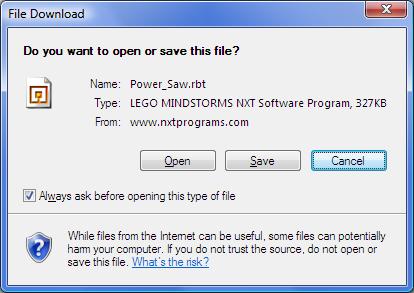This is the code for a Lego Mindstorms NXT 2.0 scorpion. The code is very simple. I was only interested in the sting mechanism so this is the only behaviour this program implements (it has no legs).


Downloading the Software Please uninstall any previous versions of LEGO® MINDSTORMS® software first. You’ll need administrator rights for the computer on which you want to install the program. Use the links below to download a copy of the software for your NXT 2.0 from set 8547. The Safari Web Browser doesn’t recognize the download as a.ZIP file. We recommend that Mac users download with Mozilla Firefox or Google Chrome.
Instructions for Windows Users • Extract the downloaded.ZIP file into a folder on your computer. • Once you have extracted the.ZIP file, open the folder and double-click the file named “Autorun.exe” • Follow on-screen the instructions to install the software. • You may need to restart your system after the installation is done. To start the program, double click the MINDSTORMS NXT Software icon on your desktop. The first time you start the program it may take a couple of minutes to get ready. Instructions for Mac Users • Make sure you allow installations from anywhere, not just from the Mac App Store and identified developers.
You can view or change this setting under “Security & Privacy” in your System Preferences. • Extract the downloaded.ZIP file into a folder on your computer. • Once you have extracted the.ZIP file, open the folder and double-click the file named “Install”. Garcea si olteni download gratis.
In the security warning that pops up, select “Don’t warn me when opening packages from this disk image” and click OK. • The NXT 2.0 installation menu will launch. Simply select your preferred language and follow the on-screen instructions. To start the program, select “LEGO Mindstorms NXT” from your Applications and click Mindstorms NXT.
The first time you start the program it may take a couple of minutes to get ready.
Robot based on the NXT platform Subject Availability 1998 ( 1998)– Lego Mindstorms is a hardware software platform produced by for the development of programmable robots based on. Each version of the system includes an intelligent brick computer that controls the system, a set of modular sensors and motors, and parts from the line to create the mechanical systems. Since creation, there have been four generations of the Mindstorms platform: the original Robotics Invention System, NXT, NXT 2.0, and EV3. With each platform release, the motor and sensor capabilities expanded.
The latest system,, was released on September 1, 2013. Some robot competitions use this set, such as the and the.
Contents • • • • • • • • • • • • • • • • • • • • • • • History [ ] The hardware and software roots of the Mindstorms Robotics Invention System kit go back to a programmable brick prototype created at the in 1987, based on the. A second prototype series was developed in the mid-1990s before the final device was released in 1998. The first visual programming environment was called LEGOsheets, since it was created by the in 1994 based on. Mindstorms is named after the book. Pre-Mindstorm [ ] Before Mindstorms, Lego had previously done some experimentation with robotic sets. One of the main foundations of these sets was the Lego Technic system and its 4.5V and later 9V system for electrical peripherals that had been evolving through the 1980s. Computer Interfaces [ ] One of the first examples of programmable Lego was the LEGO Interface-A adapter, used for the educational-only Lego Dacta TC-Logo system.
These sets from the mid-late 80's provided a dedicated hardware interface to control the Lego Technic 4.5V system using a computer, and for the first time it introduced electric Lego sensors. This interface was controlled from an IBM-PC or Apple-IIe by the use of a special version of, a simple programming language designed for use in children's education. In the mid-90's, the Lego Dacta Control Lab released as a follow-up for Lego 9V system, using a standard serial port rather than a custom hardware interface card.
This move also introduced new 9V sensors, which would later become a key component for the first-generation Mindstorms sets. It is worth noting that the Control Lab had dedicated ports for active and passive sensors, while later products like first generation Midstorms provided support for both kinds on the same ports. Technic Control Center [ ] The control center (1990) was the first programmable standalone Lego product, in the sense of being able to store sequence-based programs and run them. It featured three output ports and manual control, and it was only capable of storing linear sequences of manual input plus timing information. It could store up to two programs at once. The manual controls could be used to independently control the three motors.